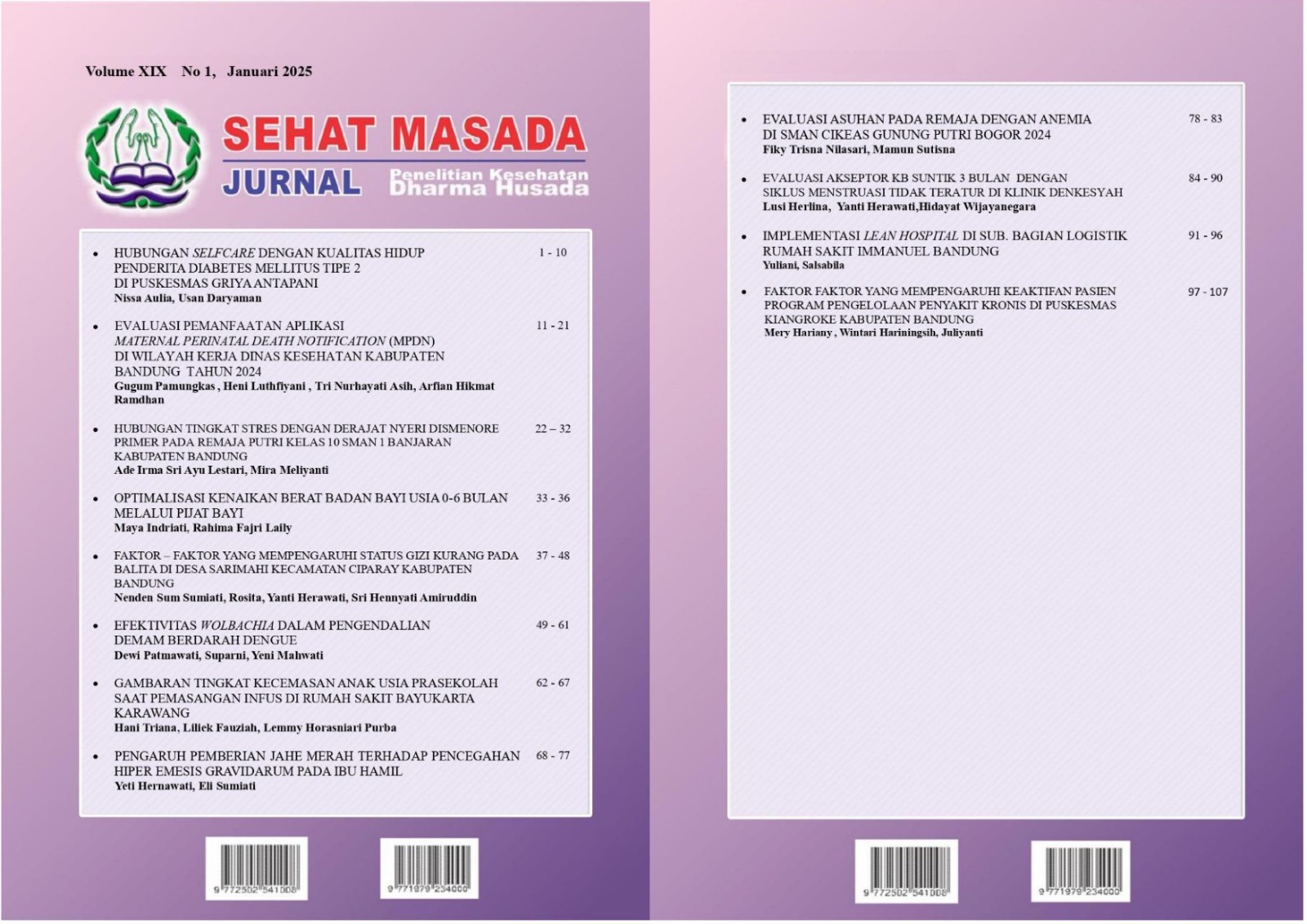EVALUASI AKSEPTOR KB SUNTIK 3 BULAN DENGAN SIKLUS MENSTRUASI TIDAK TERATUR DI KLINIK DENKESYAH
Abstract
Family Planning is a program that helps married couples to create a happy and prosperous small family by planning for pregnancy and vice versa to avoid unwanted pregnancies, get a birth that is very desirable, set intervals between pregnancies, control the time of birth in relation to the age of the couple and determine the number of children in the family. Midwifery Care in 3-Month Injectable Birth Control Acceptors with Menstrual Cycle Disorders in this study uses an evaluation model developed by Stuflebeam in the 1960s with the CIPP (Context, Input, Process and Product) Evaluation approach developed by the National Study Committee on Evaluation of Phi Delta Kappa. The purpose of the study was to find out the evaluation actions in handling menstrual disorders due to 3-month injectable birth control. This study uses a qualitative approach of a cross sectional design, where the collection of independent variables and bound variables is carried out at the same time. Sampling uses purposive sampling. The population in this study is birth control acceptors who use 3-month injectable birth control. The research was carried out in May 2024. Based on the results of the interview, in the implementation of the evaluation that has been carried out according to the standards. The evaluation of 3-month injectable birth control acceptors is carried out to the maximum, this can be seen from the follow-up to the care provided by providing counseling and counseling related to the use of appropriate contraceptives.
References
Arikunto, S. 2014. Prosedur Penelitian suatu Pendekatan Praktik. Rineka Cipta. Jakarta.
Atania, R dan Sri, W. 2016. Perbedaan Penambahan Berat Badan Pada Akseptor Kontrasepsi Suntik 3 Bulan dengan 1 Bulan Di Kelurahan Karang Kidul Kecamatan Magelang Selatan Kota Magelang. Jurnal Kebidanan, Volume 5, Edisi 10, Halaman 38.
Antika, D. A. (2014). Hubungan Penggunaan KB suntik dengan siklus Menstruasi pada Akseptor KB Suntik Diwilayah Kerja Puskesmas Ponjong I GunungKidul. hal 140.
Catur Setyorini, A. D. L. (2020). Lama penggunaan kb suntik 3 bulan dengan kejadian. 11(1), 124–133.
Dewi, A. D. C. (2018). Gambaran Efek Samping Kb Suntik Depo Medroksi Progesteron Asetat Pada Akseptor Di Bidan Praktik Mandiri ( BPM ) WILAYAH KERJA KELURAHAN SAKO PALEMBANG TAHUN 2017 Ayu Devita Citra Dewi STIK Bina Husada Palemban. 2, 38–46.
Ernawati. (2017). Hubungan Lama Penggunaan Suntik Depo Progestin Dengan Kejadian Spotting Pada Akseptor Kb Di Puskesmas. 10, 123–127.
Glasier, A. 2015. Contrasception. Dalam: Jameson, JL. Groot, LJD. (eds). Endocrinology: Adult and Pediatric. Edisi 7. Volume 2. Philadelphia: Elsevier Health Sciences
Hartanto, H. 2014. Keluarga Berencana dan Kontrasepsi. Jakarta: Pustaka Sinar Harapan.
Iin, N. 2016. Perbedaan Peningkatan Berat Badan Akseptor Kontrasepsio Suntik Satu Bulan Dengan Tiga Bulan.
Jacobstein, R., & Polis, C. B. (2014). Progestin-only contraception: Injectables and implants. Best Practice and Research: Clinical Obstetrics and Gynaecology, 28(6), 795–806. https://doi.org/10.1016/j.bpobgyn.2014.05.003
Kirana, R. 2015. Obat-obat Penting ed.6, 717. Jakarta:PT. Elex Media Computa.
Laila, N., Budiono, B., Sunarsih, S., & Aditiawarman, A. (2019). Faktor Risiko Dropout Kontrasepsi Suntik Progesteron. Pediomaternal Nursing Journal, 5(2), 166. https://doi.org/10.20473/pmnj.v5i2.13550
Medical Eligibility Criteria For Contraceptive Use (MEC). 2015. Tersedia dalam https://www.who.int/publications/i/item/9789241549158. diakses tanggal 7 Mei 2023.
Nazirun, N. (2019). Vol. 1 No.3 Oktober 2019 http://jurnal.ensiklopediaku.org Ensiklopedia Social Review. 1(3), 245–252.
Notoatmodjo, S. 2017. Metode Penelitian Kesehatan. Jakarta: Rineka Cipta.
Prawirohardjo, S. (2011). Ilmu Kandungan. Jakarta: Yayasan Bina Pustaka Sarwono.
Putri, D. Y., Nurullita, U., & Pujiati, N. (2013). Gambaran pola menstruasi akseptor kontrasepsi suntik 1 bulan dan 3 bulan (studi di BPM T Tlogosari Kota Semarang Tahun 2012). Jurnal
Kebidanan. http://103.97.100.145/index.php/jur_bid/article/view/813
Putri, N. E. K. A. (2019). Gambaran dampak penggunaan kontrasepsi hormonal pada wanita usia subur.
Raidanti, D. and Wahidin (2021) Efek KB Suntik 3 bulan (DMPA) terhadap Berat. Badan. Malang: CV. Literasi Nusantara Abadi.
Rosmiati. 2018. Perbedaan Peningkatan Berat Badan Antara Akseptor KB Suntik 1 Bulan (Cyclofem) dengan Akseptor Kb Suntik 3 Bulan (Depo Medroksi Progesteron Asetat/DMPA) Di Polindes Huko-Huko Kecamtan Pomalaa Kabupaten Kolaka. Skripsi. Program Diploma IV Kebidanan Politeknik Kesehatan Kendari. Kendari.
Riski, Y. 2019. Ananlisi Perbedaan Perubahan Berat Badan Ibu Pengguna Kontrasepsi Suntik Satu Bulan Dan Tiga Bulan.
Saifuddin, A.B. 2014. Buku Panduan Praktis pelayanan Kontrasepsi. Jakarta: Yayasan Bina Pustaka Sarwono Prawiroharjdo.
Saroha, P. 2015. Kesehatan Reproduksi dan Kontrasepsi.Jakarta:TIM.
Sugiyono. 2017. Metode Penelitian Kuantitatif, Kualitatif, dan R&D. Bandung : Alfabeta, CV.
Susanti, L. W. (2015). Hubungan lama penggunaan kontrasepsi suntik 3 bulan dengan kejadian spotting di bidan praktek swasta Tri Erry Boyolali. Jurnal Kebidanan Dan Ilmu Kesehatan, 2(2), 32–38.
Taqiyah.Y, Jama. F, H. (2020). DOI: http://dx.doi.org/10.33846/sf11210 Penggunaan Alat Kontrasepsi Suntik dan Gangguan Perdarahan Menstruasi pada Akseptor KB di Puskesmas Tompobulu Yusrah Taqiyah. 11(April), 2015–2017.
Yosin, E. P., Mudigdo, A., & Budihastuti, U. R. (2016). Effect of Hormonal Contraceptive on Sexual Life, Body Mass Index, Skin Health, and Uterine seperti kadar HB, usia menikah dll, Bleeding, in Women of Reproduction Age in Jombang, East Java. Journal of Maternal and Child Health, 01(03), 146–160. https://doi.org/10.26911/thejmch.2016.01.03.02



